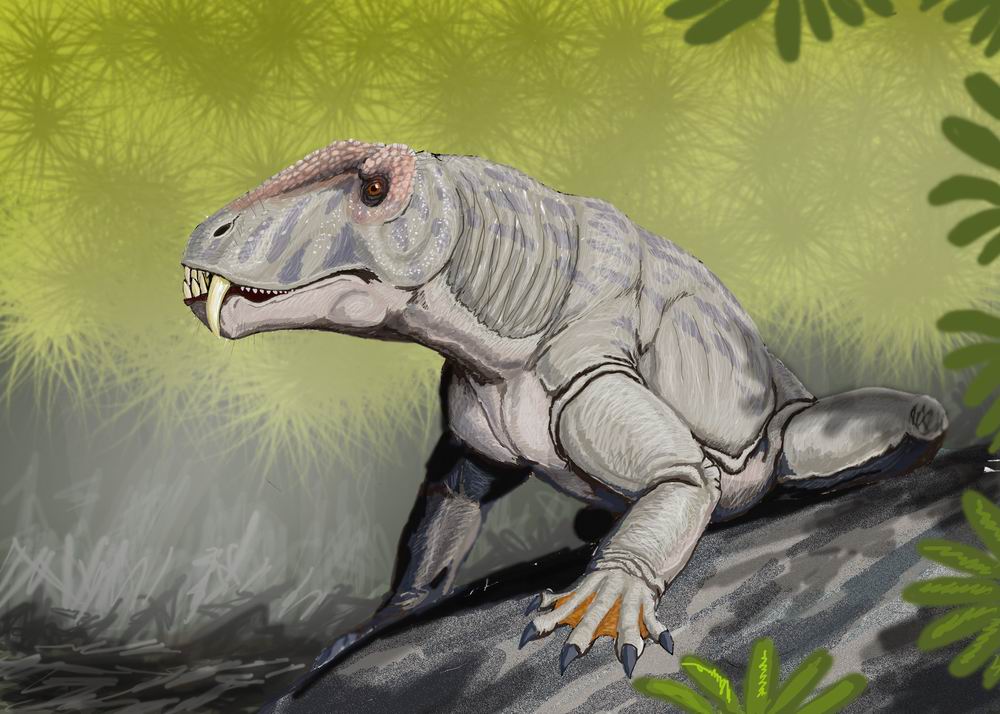- Brithopodidae
Taxobox
name = Brithopodidae

image_caption = "Doliosauriscus "
fossil_range =Middle Permian
regnum =Animal ia
phylum = Chordata
subphylum = Vertebrata
classis =Synapsid a
ordo =Therapsida
subordo =Dinocephalia
superfamilia =Anteosaur oidea
familia = Brithopodidae
genus_authority = Efremov, 1954
subdivision_ranks = Genera
subdivision = See under "included genera"Brithopodidae are a
paraphyletic family of primitive mostly carnivorousDinocephalia ns known from the MiddlePermian of Russia. Nowadays the name is used less often, being replaced byAnteosaur ia (a generic name for theclade that includes the carnivorous branch of dinocephalia (Hopson & Barghusen 1986, Rubidge & Sidor 2001).The original "
Dinosaurus ", named byJohann Fischer von Waldheim in 1845, was probably a specimen of the genus "Brithopus ".Characteristics
The Brithopodids are very primitive Eutheraspids, not far removed from ancestral synapsids. The Russian paleontologist Peter Chudinov noted that the Ocher brithopidids are similar to but slightly more advanced then the contemporary or slightly later Phthinosuchidae and Eotitanosuchidae ("
Biarmosuchus " and "Eotitanosuchus ") ( Chudinov, 1965 p.120). The skull of some Brithopodids closely resemble those of the earlyBiarmosuchia . The South African paleontologistLieuwe Dirk Boonstra pointed out the great similarity between the skull of "Syodon " and that of "Eotitanosuchus " (Boonstra 1963 p.199).Although the limbs are more upright, the postcranial skeleton retains the general form of the sphenacodont
pelycosaur s. (Carroll 1988 p.371).However, the temporal opening is greatly enlarged, indicated more space for jaw muscles and hence a much stronger bite. There are also sharp crests near the midline of the skull for attachment of jaw muscles. The canines are long, with cheek teeth adapted to piercing, and the
incisor s are also large and pointed, and intermesh when closed all of which indicates a carnivorous diet, and teeth adapted to cutting flesh from their prey (Carroll "ibid").Taxonomic history
The family was erected by Efremov in 1954 to include a number of large carnivorous
therapsid s found in theCopper Sandstones and otherCis-Uralian localities, including the Cis-Uralian Deinocephalian Complexes and the Isheevian Deinocephalian Complex (Olsen 1962 p.57).Olsen included the Brithopodidae with the Phthinosuchidae and Biarmosuchidae in the larger category "Eotheriodontia". He did not consider the Brithopodids related to herbivorous Dinocephalia (
Tapinocephalia ) but saw them as related to theGorgonopsia and otherTheriodont s. His theory is not longer followed by current workers in this field.Boonstra retained most of the Russian genera (along with "Deuterosaurus") in the Brithopodidae, but transferred several genera to the
Anteosauridae , the family based on "Anteosaurus ", which he erected at the same time. However he considered the two groups closely related, the Brithopodidae differing from the Anteosauridae by being somewhat more primitive.Hopson and Barghusen, in the first cladistic study of the Therapsida, coined the term
Anteosauria , and synonymised the families Brithopodidae and Anteosauridae. Their "Anteosaurini" is probably equivalent to Boonstra's "Anteosauridae", in that both include "Anteosaurus" and "Doliosaurus"/"Doliosauriscus". (see Hopson & Barghusen 1986 p.91 and Boonstra 1969 pp,59-60)King 1988 downgraded the Brithopodids to subfamily status (Brithopodinae).
In 1994, Ivakhnenko transferred several Brithopodid genera to the family
Syodontidae .Included genera
The following genera have been or are included in the family:
* "Admetophoneus " is included in theAnteosauridae by Boonstra 1969
* "Archaeosyodon " may be a Titanosuchid
* "Brithopus "
* "Chthomaloporus "
* "Deuterosaurus " is a herbivorous genus that is sometimes placed in its own family.
* "Doliosauriscus " (originally "Doliosaurus") is included in Anteosauridae "sensu" Boonstra 1969 and the Anteosaurini "sensu" Hopson & Barghusen 1986. It is considered closely related to "Anteosaurus "
* "Eosyodon" is an American genus that was added by Everett Olson but is now known to be a chimera.
* "Mnemeiosaurus "
* "Notosyodon " is probably included under theSyodontidae of Ivakhnenko 1994
* "Syodon " is probably included under theSyodontidae of Ivakhnenko 1994
* "Titanophoneus " is listed as Brithopodid by Carroll 1988, and Anteosaurinae by Hopson & Barghusen 1986. A number of other forms have been discovered since, in South Africa ("Australosyodon ") and China ("Stenocybus ", "Sinophoneus "). However with thecladistic revolution, the name "Brithopodidae" is now falling out of fashion in favour of "Anteosaur ia", and so they are generally not included in the family.References
* Boonstra, L. D. 1963, Diversity within the South African Dinocephalia. S. Afr. J. Sci. 59: 196-206.
* ----- 1969, "The Fauna of the Tapincephalus Zone (Beaufort Beds of the Karoo)," Ann. S. Afr. Mus. 56 (1) 1-73, pp. 35-38
* Carroll, R. L. (1988), "Vertebrate Paleontology and Evolution", WH Freeman & Co.
* Chudinov, P. K. 1965, "New Facts about the Fauna of the Upper Permian of the USSR", "Journal of Geology ", 73:117-30
* Hopson, J.A. and Barghusen, H.R. (1986), An analysis of therapsid relationships in N Hotton, III, PD MacLean, JJ Roth and EC Roth, "The Ecology and Biology of Mammal-like Reptiles",Smithsonian Institute Press , pp. 83-106
* King, G. M., 1988 "Anomodontia" Part 17 C, "Encyclopedia of Paleoherpetology",Gutsav Fischer Verlag , Stuttgart and New York,
* Olsen, E. C., 1962, Late Permian terrestrial vertebrates, USA and USSR "Transactions of the American Philosophical Society ", new series, 52: 1–224.
* Rubidge, B.S. & Sidor, C.A. 2001, Evolutionary patterns among Permo-Triassic therapsids. "Ann. Rev. Ecol. Syst." 32: 449-480.Links
* [http://www.palaeos.com/Vertebrates/Units/400Therapsida/400.html Palaeos] - detailed description
* [http://www.fmnh.helsinki.fi/users/haaramo/metazoa/deuterostoma/Chordata/Synapsida/Dinocephalia/Anteosauria.htm Mikko's Phylogeny Archive] - list of genera in the form of acladogram
Wikimedia Foundation. 2010.
